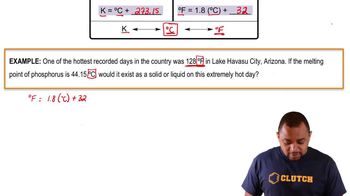You have a sample of gas in a container with a movable piston, such as the one in the drawing. b. Redraw the container to show what it might look like if the external pressure on the piston is increased from 1.0 atm to 2.0 atm while the temperature is kept constant.
A 500 mL incandescent light bulb is filled with 1.5 * 10-5 mol of xenon to minimize the rate of evaporation of the tungsten filament. What is the pressure of xenon in the light bulb at 25 _x001F_C?
 Verified step by step guidance
Verified step by step guidanceKey Concepts
Ideal Gas Law

Molar Volume of a Gas

Temperature Conversion

Consider the sample of gas depicted here. What would the drawing look like if the volume and temperature remained constant while you removed enough of the gas to decrease the pressure by a factor of 2? (a) It would contain the same number of molecules. (b) It would contain half as many molecules. (c) It would contain twice as many molecules. (d) There is insufficient data to say.
Imagine that the reaction 2 CO1g2 + O21g2¡2 CO21g2 occurs in a container that has a piston that moves to maintain a constant pressure when the reaction occurs at constant temperature. Which of the following statements describes how the volume of the container changes due to the reaction: (a) the volume increases by 50%, (b) the volume increases by 33%, (c) the volume remains constant, (d) the volume decreases by 33%, (e) the volume decreases by 50%.
